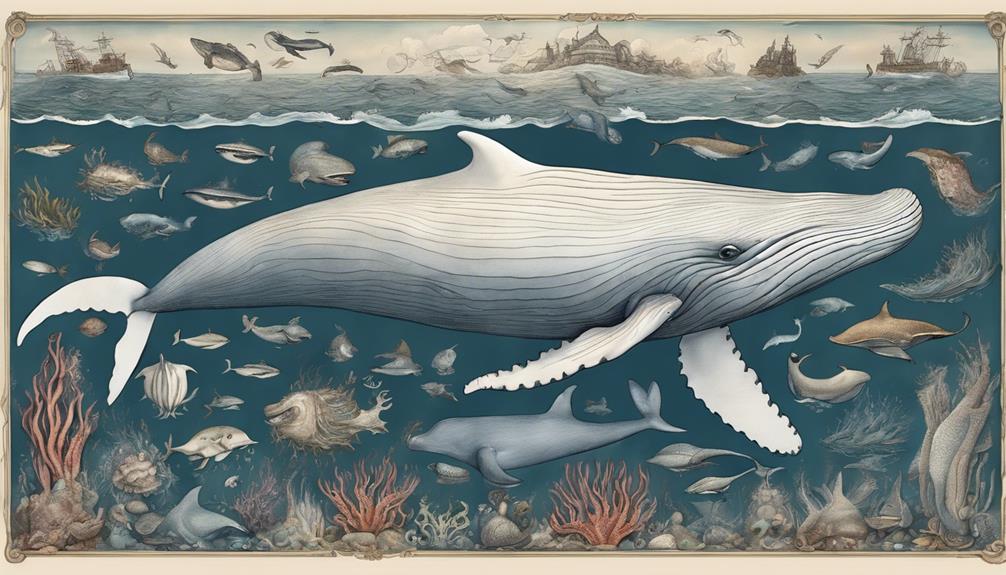Whales such as sperm whales that have large foreheads possess distinct characteristics. Their bulky heads contain a spermaceti organ used for regulating buoyancy, which houses waxy substances to alter its density. The prominent forehead aids in generating strong echolocation clicks crucial for hunting. Echolocation assists them in navigation and communication within their surroundings. Their evolutionary traits allow for survival in a variety of marine environments. The melon located in their forehead acts as an acoustic lens for precise echolocation. Noteworthy problem-solving abilities and emotional depth make them fascinating subjects of study. These captivating creatures exhibit intricate social behaviors. Explore more intriguing facts about these extraordinary whales with large foreheads.
Key Takeaways
- Sperm whales have massive heads with spermaceti organs for buoyancy and echolocation.
- Big foreheads aid in producing powerful echolocation clicks for hunting success.
- Forehead structures enhance sound wave transmission and reception for effective communication.
- Melon in the forehead acts as an acoustic lens, optimizing echolocation accuracy.
- Their intelligence, problem-solving skills, and emotional depth make them intriguing marine mammals.
Unique Features of Whales Foreheads
Exploring the unique features of whales' foreheads reveals fascinating adaptations important to their survival and hunting strategies. Sperm whales, known for their massive heads, possess a remarkable forehead organ called the spermaceti organ. This organ, located in the front of their heads, contains a special waxy substance that aids in buoyancy control. By altering the density of the spermaceti oil, sperm whales can effectively regulate their depth in the water, allowing them to dive to great depths in search of prey.
The presence of this forehead organ isn't just for buoyancy, but also plays a significant role in the hunting capabilities of sperm whales. The large forehead helps them produce powerful echolocation clicks, which they use to navigate, communicate, and hunt. This unique adaptation allows sperm whales to locate prey even in the darkest depths of the ocean, showcasing the incredible evolutionary strategies that have enabled their survival in diverse marine environments.
Echolocation Abilities of Forehead Whales

Whales with big foreheads, such as sperm whales, possess remarkable echolocation abilities. Their large foreheads, housing the spermaceti organ, aid in focusing and amplifying sound waves for navigation and hunting.
The unique structure of their foreheads enhances their capacity to produce and interpret echolocation signals effectively.
Forehead Whales Sonar
In the depths of the ocean, the melon in the forehead of whales, like sperm whales, acts as a sophisticated acoustic lens for their precise echolocation abilities. This specialized organ helps these forehead whales to focus and direct their echolocation signals with exceptional accuracy.
By using echolocation, these whales can navigate their deep-sea environments, locate prey, and communicate effectively over long distances. The unique structure of their foreheads allows them to efficiently transmit and receive sound waves, enhancing their hunting and social interactions.
Sperm whales, with their large foreheads, rely on this advanced echolocation system to be highly effective hunters in the ocean depths. The sonar capabilities of forehead whales are truly fascinating and showcase the incredible adaptations these marine mammals have evolved for survival.
Unique Echolocation Methods
Utilizing their specialized acoustic lens in the forehead, sperm whales masterfully emit and interpret clicks for intricate echolocation purposes. These magnificent creatures showcase remarkable abilities that intrigue and inspire innovation, such as:
- Crafting precise sound waves for detecting objects in the vast ocean depths.
- Fine-tuning their echolocation skills to communicate effectively within their pod.
- Adapting their clicking patterns to navigate through challenging underwater environments.
- Leveraging echolocation to hunt and secure prey with astonishing accuracy.
Sperm whales' echolocation methods not only demonstrate their intelligence but also highlight the incredible adaptations that have evolved over time to thrive in their marine habitat.
Forehead Structures and Sound
Crafting precise sound waves for detecting objects in the vast ocean depths is a remarkable skill demonstrated by sperm whales and other forehead whales with specialized melons aiding in their echolocation abilities.
These forehead whales, equipped with unique structures in their heads, use echolocation to locate prey, navigate in dark waters, and communicate with their pod members. The melon's role in focusing and directing echolocation sounds is vital for their hunting success.
The efficiency and accuracy of echolocation abilities can vary based on the size and shape of the whale's forehead. Sperm whales, in particular, are known for their powerful echolocation clicks generated by their large foreheads, enabling them to dive deep into the ocean in search of squid.
Social Behavior of Forehead Whales

Traversing the vast oceans, forehead whales like sperm whales display intricate social structures within their pods. These intelligent creatures engage in a variety of social behaviors that are both fascinating and essential for their survival:
- Communication Excellence: Forehead whales use a diverse range of vocalizations and behaviors to communicate within their pods, ensuring efficient coordination and bonding.
- Matrilineal Leadership: Female sperm whales take the lead in matrilineal groups, showcasing strong social ties and cooperative behaviors that are pivotal for the group's well-being.
- Care and Cooperation: Social interactions among forehead whales involve caregiving for young ones, collaborative hunting strategies, and the protection of vulnerable pod members, highlighting their empathetic nature.
- Survival Strategy: The intricate social behavior of forehead whales plays a significant role in their success in marine environments, emphasizing the importance of teamwork and unity for their survival.
These social dynamics not only showcase the complexity of forehead whales but also underline the significance of social bonds in their daily lives.
Intelligence of Whales With Big Foreheads

Whales with big foreheads, such as sperm whales, possess the largest brains in the animal kingdom. This brain size difference between male and female whales of the same species indicates potential variations in cognitive abilities.
Their problem-solving skills and intricate social behaviors highlight the remarkable intelligence of whales with big foreheads.
Brain Size Comparison
With brains weighing an average of 17 pounds, sperm whales possess remarkable cognitive abilities attributed to their large brain size, particularly the highly convoluted structure influenced by the spermaceti organ in their heads. When comparing brain sizes, it's evident that sperm whales stand out in the animal kingdom. Their impressive brain capacity allows for advanced thinking and problem-solving skills. This unique characteristic sparks curiosity about the depths of their intelligence. As we investigate the mysteries of these magnificent creatures, we uncover the intricate workings of their minds. Exploring the correlation between brain size and intelligence in sperm whales opens doors to innovative research possibilities. Through studying their cognitive capabilities, we inch closer to understanding the complexities of these fascinating marine mammals.
- The intricate connection between brain size and cognitive abilities ignites scientific curiosity.
- Investigating the depths of sperm whale intelligence reveals a world of mystery and wonder.
- Research on sperm whale brains paves the way for innovative discoveries in marine biology.
- Understanding the unique cognitive skills of sperm whales offers insights into the animal kingdom's diversity.
Problem-Solving Abilities
Exploring the problem-solving prowess of whales with prominent foreheads reveals a fascinating glimpse into their advanced cognitive abilities.
Whales, especially those like sperm whales with big foreheads, showcase remarkable problem-solving skills.
Their large foreheads house complex brains that are linked to high intelligence levels and cognitive functions. Studies indicate that these whales possess intricate social structures and exceptional communication abilities, further enhancing their problem-solving capabilities.
The spermaceti organ located in their prominent foreheads might also contribute to their adeptness in handling various tasks.
Observing whales with big foreheads, such as sperm whales, in their natural habitat provides valuable insights into how these magnificent creatures navigate and overcome challenges, demonstrating their advanced problem-solving skills in action.
Problem-Solving Skills of Forehead Whales

Their impressive problem-solving skills set forehead whales apart in the marine world, showcasing their advanced cognitive abilities. These abilities make them exceptional problem solvers, allowing them to navigate complex social dynamics and environments with ease.
Here are some fascinating aspects of the problem-solving skills of forehead whales:
- Collaborative Strategies: Forehead whales, particularly sperm whales, are known for their cooperative behaviors when hunting for prey, working together to guarantee successful outcomes.
- Social Intelligence: Their advanced communication skills within their pods indicate a high level of social intelligence, enabling them to coordinate effectively during various activities.
- Adaptive Thinking: The unique forehead structure of sperm whales is thought to be linked to their exceptional cognitive capabilities, suggesting an ability to adapt and innovate in challenging situations.
- Strategic Planning: Sperm whales exhibit strategic hunting techniques, indicating a level of planning and foresight that's crucial for their survival in the marine environment.
These remarkable problem-solving skills contribute to the success and adaptability of forehead whales in their natural habitat.
Emotional Depth in Forehead Whales

Revealing the emotional depth residing within sperm whales with big foreheads exposes a complex world of social connections and expressive behaviors. These majestic creatures, known for their intricate social structures, possess a remarkable capacity for emotional depth.
The large forehead of sperm whales, housing the spermaceti organ, isn't just a pivotal feature but a key to their potential intelligence and emotional capabilities. Through their big foreheads, sperm whales engage in echolocation, communication, and possibly even expressing emotions.
Research indicates that these whales have unique vocalizations through which they engage in social interactions and convey emotions within their pods. The distinctive forehead of sperm whales plays an essential role in their social behaviors, fostering potential emotional connections within their close-knit communities.
Understanding the emotional depth of sperm whales with big foreheads sheds light on the rich tapestry of their lives beneath the waves.
Conservation Importance for Forehead Whales

Whales with prominent foreheads, such as sperm whales, are essential to marine ecosystem conservation efforts. When considering the conservation importance of forehead whales, several key points come to mind:
- Protecting their habitats is fundamental for ensuring the survival of these majestic creatures.
- By reducing human impact, we can safeguard the delicate balance these whales help maintain in the ocean's food chain.
- Preserving forehead whales isn't just about saving a species; it's about preserving biodiversity and promoting sustainable marine environments for future generations.
- Through effective conservation strategies focused on these unique whales, we can make significant strides in marine conservation efforts.
Understanding the critical role that whales with big foreheads play in the ecosystem motivates us to take action towards their preservation. By prioritizing the conservation of these magnificent creatures, we aren't only protecting them but also safeguarding the health of our oceans and the diverse life within them.
Research on Forehead Whales Physiology

Studying the physiology of forehead whales provides valuable insights into their unique adaptations for survival in the marine environment. One key focus of research is the spermaceti organ found in forehead whales, like sperm whales. This organ plays an essential role in their ability to control buoyancy and use echolocation. The spermaceti organ contains a waxy substance that was historically sought after for candles and lubricants. Scientists are intrigued by how this organ aids in profound dives and sound production for communication.
The structure of the spermaceti organ allows forehead whales to regulate their buoyancy by adjusting the density of the oil within it. By studying the size and function of this organ, researchers gain a better understanding of how it influences the survival, behavior, and evolutionary history of forehead whales. Through this research, we uncover the remarkable ways in which these whales have evolved to thrive in their oceanic habitats.
Communication Patterns of Forehead Whales

Whales with big foreheads, such as sperm whales, use their unique head structure for communication purposes. They produce clicks and codas through their large foreheads to interact with others and navigate the ocean.
The specialized anatomy of their foreheads allows these whales to create powerful sonar signals for long-distance communication.
Forehead Whales Vocalizations
With their intricate patterns of clicks and codas, forehead whales, similar to sperm whales, engage in sophisticated communication for various purposes such as socializing and traversing their environment.
- Vocalizations are essential for social interactions, aiding in group cohesion and maintaining relationships.
- The diverse sounds produced convey information about the environment and potential prey, showcasing their intelligence.
- Through vocal dialects, whales express individuality within the group, fostering a sense of identity and belonging.
- The complex communication system of forehead whales highlights their advanced cognitive abilities and adaptability in various habitats.
Social Signaling Behaviors
After investigating the vocalizations of forehead whales, it becomes apparent that their social signaling behaviors through intricate communication patterns are essential to their group dynamics and activities coordination. Whales with prominent foreheads, such as sperm whales, rely on various sounds like clicks, creaks, and codas to convey messages within their groups. To highlight the significance of social signaling in these whales, let's explore a table showcasing some of the key behaviors associated with their communication patterns:
| Social Signaling Behaviors | Description | Importance |
|---|---|---|
| Clicks | Short, distinct sounds | Signaling location |
| Creaks | Low-pitched groans | Expressing emotions |
| Codas | Complex patterns | Group coordination |
Understanding these communication methods provides valuable insights into the social structures and interactions of these fascinating creatures.
Unique Forehead Whale Sounds
Delving into the domain of oceanic communication, the distinct clicking sounds emitted by forehead whales, like sperm whales, reveal a sophisticated system of echolocation and social interaction. These unique sounds are a demonstration of the remarkable abilities of sperm whales and other forehead whales:
- The complex patterns of clicks, creaks, and codas showcase the intricate communication methods of forehead whales.
- Modulation and direction of clicking sounds through their large foreheads demonstrate advanced communication techniques.
- Forehead structures enable whales to focus and amplify sounds, enhancing their navigation and social interactions underwater.
- The significant role played by the forehead in acoustic signaling highlights the evolutionary advantage of these specialized structures in the world of marine communication.
Captivating Behaviors of Forehead Whales

Observing the enthralling behaviors of sperm whales, with their large foreheads, reveals the intricate ways in which these majestic creatures utilize their specialized organs and distinctive features.
Sperm whales, known for their impressive foreheads, showcase captivating behaviors that demonstrate the depth of their intelligence and social interactions.
The specialized spermaceti organ housed in their foreheads not only aids in pivotal buoyancy control but also plays a vital role in sound production for communication and hunting purposes.
When these whales use their big foreheads to produce powerful clicks, it highlights their advanced echolocation abilities.
Additionally, the unique shape of their foreheads contributes significantly to their deep-sea diving skills, allowing them to navigate the ocean depths with ease.
The large foreheads of sperm whales aren't just a physical feature but a fundamental aspect of their mysterious intelligence and complex behaviors, making them truly fascinating creatures to study.
Frequently Asked Questions
What Are Some Interesting Facts About the Bowhead Whale?
Bowhead whales stand out with their thick blubber and unique features. Their massive bow-shaped heads break through ice for food. No dorsal fin helps navigate the Arctic. Dual blowholes provide extra oxygen for deep plunges.
What Are 10 Fun Facts About Whales?
Whales are incredible creatures, each with its own unique charm. From the depths they swim to the songs they sing, these majestic beings never fail to amaze and inspire awe in me.
What Whale Has a Bumpy Forehead?
The sperm whale is known for its unique bumpy forehead, housing the spermaceti organ. This organ contains a valuable waxy substance historically used in candles. Sperm whales utilize their distinctive heads for echolocation and deep diving.
What Are 3 Interesting Facts About Whaling?
Whaling, a controversial practice, has a rich history affecting whale populations. Despite bans, some countries continue hunting for various reasons. Technological advancements like harpoons and factory ships have shaped the industry.
What Are Some Unique Physical Features of Whales with Big Foreheads?
Whales with big foreheads, such as the sperm whale, have unique physical characteristics that set them apart. Their large, bulbous heads contain a cavity filled with a substance called spermaceti, which helps with buoyancy and echolocation. This contrasts between ermine mink with their sleek and slender bodies.
Conclusion
To sum up, whales with large foreheads are truly captivating creatures with distinctive characteristics, intelligence, and social behaviors.
Their echolocation abilities, problem-solving skills, and communication patterns make them a significant part of the marine ecosystem.
By researching and preserving these incredible animals, we can gain more knowledge about the ocean and how to safeguard it.
So next time you encounter a whale with a prominent forehead, remember all the remarkable things they can accomplish!










